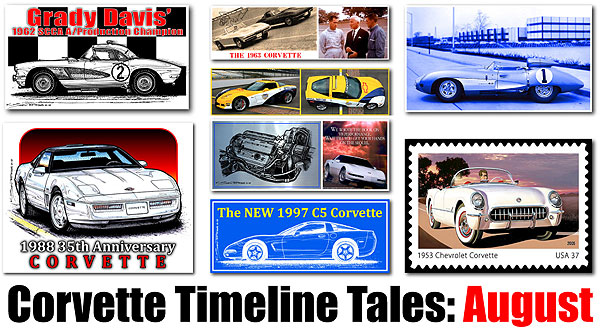Eight important Corvette events through the decades that happened in August.
This story was first published in the September 2016 issue of Vette Vues Magazine.
August 3, 2006 – All-New C6 Z06 serves as Pace Car for the Allstate Brickyard 400 at Indy
 2006 marked the 13th time a Chevrolet car paced the Brickyard 400, but it was the first time a Corvette served as the pace car for the series. Going all the way back to the 1978 Indy 500 Corvette Pace Car, powered by the 220-horsepower 350 L82 engine, off-the-line Corvettes have always had plenty of grunt and suspension to easily pace major races. The 2006 Z06 with its 505-horsepower LS7 was a thunderous beast compared to the ’78 Corvette Indy 500 Pace Car. But the common denominator between the two cars is that aside from the strobe lights, strobe light roof bar, and five-point racing harness, all Corvette pace cars are “off the line” Corvettes – abet thoroughly prepared for the task.
2006 marked the 13th time a Chevrolet car paced the Brickyard 400, but it was the first time a Corvette served as the pace car for the series. Going all the way back to the 1978 Indy 500 Corvette Pace Car, powered by the 220-horsepower 350 L82 engine, off-the-line Corvettes have always had plenty of grunt and suspension to easily pace major races. The 2006 Z06 with its 505-horsepower LS7 was a thunderous beast compared to the ’78 Corvette Indy 500 Pace Car. But the common denominator between the two cars is that aside from the strobe lights, strobe light roof bar, and five-point racing harness, all Corvette pace cars are “off the line” Corvettes – abet thoroughly prepared for the task.
One ironic tidbit is that the production C6 Z06 had a top speed of 198 mph. The average speed for the race was only 137.182 mph and the pole position speed was 182.778 mph. So, could a race-prepared, stock C6 Z06 last in a 500-mile race at the Brickyard? Sure! Could a race-prepared, stock C6 Z06 win against an all-out Indy car from 2006? Probably not, but it’s an interesting question. How would a 2006 C6.R Corvette stack up against an Indy car? Care to Bench Race a little?
August 5, 1961 – At the Wisconsin Grand Prix, Richard “The Flying Dentist” Thompson races Grady Davis’ Gulf Oil 1962 Corvette to a 1st place win in SCCA A/Production class
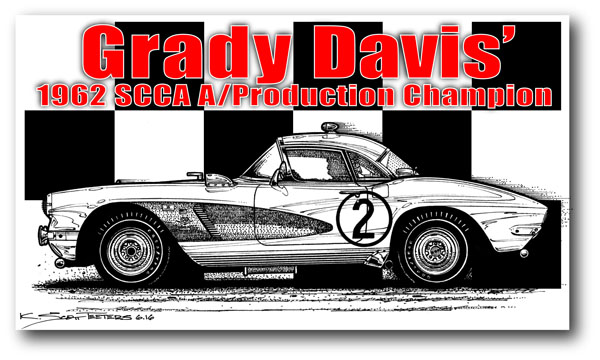 It is mind-boggling how many early Corvettes were either ordered from the factory with the full-compliment of racer parts, unofficially known as “Duntov’s Racer Kits”, and/or, were built using the Racer Kit parts that were bolted on a Fuelie or dual-quad Corvette. Of course, just having the parts on the car, either factory or customer installed, didn’t instantly create a turn-key racecar – the cars had to be prepared for racing. Preparation and not over-building the engine, so it wouldn’t grenade, is also essential. The larger displacement 327 small-block used in the 1962 Corvette was enough to put the car into the A/Production class, whereas Grady Davis’ 1961 Corvette used a 283 Fuelie was in B/Production class. With Dr. Dick Thompson behind the wheel, Davis’ Fuelie Corvette won 12 out of 14 races. That’s an 85.7-percent win rate!
It is mind-boggling how many early Corvettes were either ordered from the factory with the full-compliment of racer parts, unofficially known as “Duntov’s Racer Kits”, and/or, were built using the Racer Kit parts that were bolted on a Fuelie or dual-quad Corvette. Of course, just having the parts on the car, either factory or customer installed, didn’t instantly create a turn-key racecar – the cars had to be prepared for racing. Preparation and not over-building the engine, so it wouldn’t grenade, is also essential. The larger displacement 327 small-block used in the 1962 Corvette was enough to put the car into the A/Production class, whereas Grady Davis’ 1961 Corvette used a 283 Fuelie was in B/Production class. With Dr. Dick Thompson behind the wheel, Davis’ Fuelie Corvette won 12 out of 14 races. That’s an 85.7-percent win rate!
Where it gets crazy is how many winning and championship Corvettes were retrofitted back to streetcars and then sold as daily drivers! Yes, many people owned these cars and did not know that their streetcar was once a fire-breathing racing car or racing champion. This happened to the three 1960 Briggs Cunningham Le Mans Corvette racers and the Grady Davis 1961 Corvette that won the SCCA B/Production Championship in 1961 and 1962!
Of course, finding these cars and then bringing them back to their glory days configuration is part of the thrill of these cars. In 2009 when the fully-restored Grady Davis 1962 Gulf One Corvette went to auction, it brought in a staggering $1,485,000! A few months before, the Grady Davis 1963 Gulf Oil Corvette sold at auction for $1,113,000. If you follow car auctions one thing is clear – the big bucks go to championship, celebrity, or super low-production cars. Even a “name” such as John Greenwood, by itself, isn’t enough. In 2015, Greenwood’s Sebring ’75 Corvette stalled out at auction at $300,000. The car was bloody fast and beautifully restored – but had no championship status in its lineage, so no big payday for the seller.
August 10, 1993 – Deep inside the inner sanctum of GM, the 1997 Corvette program begins the “Concept Alternatives Selection” process. It was time to justify the C5!
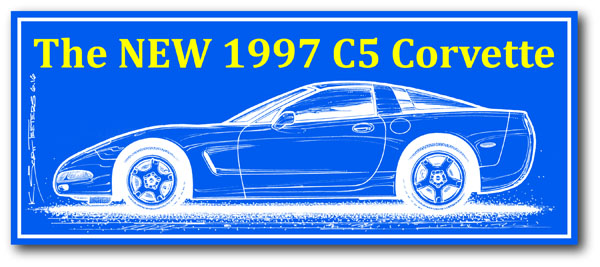 Dave Hill was officially crowned as the third Chief Engineer for the Corvette on November 18, 1992 – talk about big shoes to fill! Duntov was a living legend even in the 1950s. Duntov’s successor, Dave McLellan had the challenge of redesigning Zora’s Corvette and delivered the very successful C4 Corvette. While C4s are today in the lower strata of Corvette desirability, there were many C4 brutes from 1984 to 1996. Noteworthy C4s include the ’90 to ’95 ZR-1s, the purpose-built Corvette Challenges racers, the Callaway Twin-Turbos, the Guldstrand G80, and G90 cars, the Tommy Morrison speed record holder ZR-1, and the astonishingly fast 1988, 254.7-mph Callaway Sledgehammer Corvette!
Dave Hill was officially crowned as the third Chief Engineer for the Corvette on November 18, 1992 – talk about big shoes to fill! Duntov was a living legend even in the 1950s. Duntov’s successor, Dave McLellan had the challenge of redesigning Zora’s Corvette and delivered the very successful C4 Corvette. While C4s are today in the lower strata of Corvette desirability, there were many C4 brutes from 1984 to 1996. Noteworthy C4s include the ’90 to ’95 ZR-1s, the purpose-built Corvette Challenges racers, the Callaway Twin-Turbos, the Guldstrand G80, and G90 cars, the Tommy Morrison speed record holder ZR-1, and the astonishingly fast 1988, 254.7-mph Callaway Sledgehammer Corvette!
So, Mr. Hill had the daunting task of pulling together the new design and then justifying the new Corvette’s existence. The “Concept Alternatives Selection” is where the engineers and bean counters go head-to-head. Virtually every part, procedure, and design layout was presented, defended, and decided on. The C5 program was provisionally passed, pending a two-week review of some components.
Dave Hill started his engineering career at GM in 1965 as a Cadillac engine engineer and stayed in the Caddy division until being promoted to Chief Engineer for the Corvette line in 1992. Yes, Hill was there when Cadillacs were cushy living rooms on wheels, where a floaty ride, options, bigness, and more bigness were better. What most of us didn’t notice was that as the 1980s and early 1990s wore on Cadillacs were changing. They still looked conservative but were becoming stout luxury performers.
Part of what Dave Hill brought to the Corvette party was the attention to quality – a point that Corvettes often had problems with, although QC was vastly improved after the move to the Bowling Green Assembly Plant. When the C5 was completed, it had just over 1,200 fewer parts engineered into the car. Not only was that more efficient, but that’s less assembly time, less parts inventory, and fewer things to go wrong or rattle apart. By 1999 Hill’s structural engineers had done as much to the C5 Corvette’s structure as they could, so it was time to start work on the C6! Dave Hill retired on January 1, 2006, and is also credited with starting the C5-R Corvette Racing Program and the implementation of the C6.
August 12, 1991 – Production of 1992 Corvettes begins and the Mid-Cycle Refresh is complete!
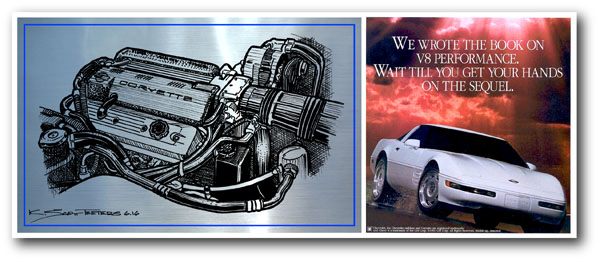 New cars typically start production in the middle of the summer for their fall launch, so what’s so special about the start of the 1992 Corvette? The 1992 Corvette was the ninth iteration of the C4 Corvette and represented the third installation of what, in retrospect, was the C4’s “Mid-Cycle Refresh.”
New cars typically start production in the middle of the summer for their fall launch, so what’s so special about the start of the 1992 Corvette? The 1992 Corvette was the ninth iteration of the C4 Corvette and represented the third installation of what, in retrospect, was the C4’s “Mid-Cycle Refresh.”
The refresh was rolled out in three phases. First, the interior was completely revised. The rectangular, modular style of the 1984 to 1989 interior did not age well. The new design for 1990 was somewhat reminiscent of the 1963-1967 hooped dash design. Overall, it was a nice refresh.
For 1991 the Corvette received all-new front and rear bumper covers. The front cover had the driving lights and side-marker lights incorporated into one continuous visual unit that wrapped around the front-to-side corners. This design would carry through to 1996. The front fender vents were revised for the first time on the C4 and featured four horizontal recesses with openings at the forward leading edge. This design carried through to 1994. The rear bumper cover received new taillight shapes that were very similar to the ZR-1 – rectangular with large radius corners. This was the first break from the tradition of “round” taillights that started with the 1963 Sting Ray. The 1991 Corvette got new aluminum wheels with restyled fan blades and a small button-style center. These wheels would be standard through 1996. And lastly, the previously black horizontal bodyside moldings were now the same color as the rest of the body. The overall look “softened” the C4’s previous angular look.
The third and final part of the C4 mid-cycle refresh was under the hood. Yes, the LT1 moniker was back, packing 300 horsepower, a whopping 50-horsepower boost for the Corvette. The small-block Chevy engine was modified enough to be named “Generation II.” Changes included a new “reverse cooling” system that delivered cooled coolant to the heads first, then down into the engine. This kept the heads cooler and allowed for an increase in compression and greater spark advance. All-new castings included the block, aluminum heads, timing cover, water pump, intake manifold, and accessory brackets.
In terms of performance, 1991 to 1992 offered the biggest jump in performance of the base Corvette for the entire C4 generation. The 1992 LT1 Corvette could run the quarter-mile in the high 13s, with 0-to-60 times around 5.5 seconds. While that might read as pretty anemic by today’s standards, the 1992 base Corvette could run with big-block Corvettes of the olden days. And, the 1992 Corvette got over double the fuel mileage! The high-performance Corvette was back!
August 20, 2005 – The United States Postal Service issued “America on the Move: ‘50s Sporty Cars” commemorative stamps
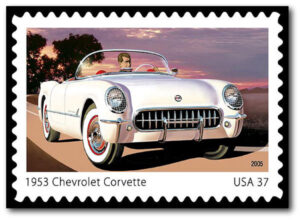 The automobile is arguably one of the defining elements of Americana. After all, America invented the car culture. It took a long time, but the United States Postal Service has gotten on board with America’s love affair with commemorative edition, post-WW II, and classic car postage stamps.
The automobile is arguably one of the defining elements of Americana. After all, America invented the car culture. It took a long time, but the United States Postal Service has gotten on board with America’s love affair with commemorative edition, post-WW II, and classic car postage stamps.
The commemorative set of five stamps featured 1950s-designed cars that were “cutting edge” in their day and included: the 1953 Corvette, the 1954 Kaiser Darrin, the 1952 Nash-Healey, the 1953 Studebaker, and the 1955 Ford Thunderbird. Noland Adams’ 1953 Corvette was the model used in the creation of the original stamp art. Adams is an author, Corvette historian, and 2003 National Corvette Museum Hall of Fame inductee.
The artist for the stamp series was advertising designer and GM illustrator, Art Fitzpatrick and the designer was Carl Herman. The USPS later went on to produce more commemorative edition classic car stamps, including “50s Fins and Chrome”, “Muscle Cars” and “Hot Rods Forever.” And lastly, the price of the 2005 America on the Move: ‘50s Sporty Cars” was just 37 cents! A book of 20 stamps was $7.40.
August 21, 1962 – Chevrolet presents the all-new 1963 Sting Ray to the automotive press and news reporters
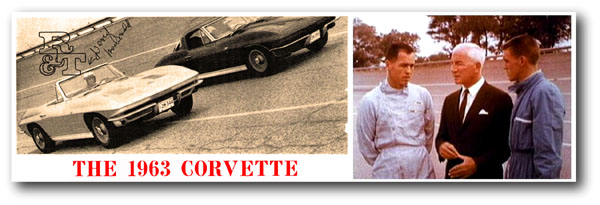 The only thing hotter than an August day in Michigan was the all-new, 1963 Corvette Sting Ray. The GM Proving Ground was first opened in 1924 and was the industry’s first dedicated automobile testing facility. Located in Milford, Michigan, the facility is huge and today has 4,000 acres, 107 buildings, and employs around 4,800 people. Some say that in the summer months, out on the 4,000-acre black asphalt surface, the temperature can reach 140 degrees!
The only thing hotter than an August day in Michigan was the all-new, 1963 Corvette Sting Ray. The GM Proving Ground was first opened in 1924 and was the industry’s first dedicated automobile testing facility. Located in Milford, Michigan, the facility is huge and today has 4,000 acres, 107 buildings, and employs around 4,800 people. Some say that in the summer months, out on the 4,000-acre black asphalt surface, the temperature can reach 140 degrees!
But in the summer of ’62, it was “conditions be damned!” There was an all-new Corvette to be announced! Picture in your mind’s eye what cars looked like in 1962 – even new cars. Heck, pre-WW II cars were still commonly seen on the road. Then look at the 1963 Sting Ray Coupe and Roadster. The Bill Mitchell / Peter Brock / Bob Veryzer / Larry Shinoda Sting Ray looked like “THE FUTURE” had arrived! There was literally NOTHING like it on the road. An instant American Classic was launched and Chevrolet put on a show.
Zora Arkus-Duntov was the Master of Ceremony and to spice up the event, he hired SCCA Champion driver Dr. Dick “The Flying Dentist” Thompson and California Corvette racer, Dave MacDonald, one of THE up-and-coming driving talents, to show the public what the new Corvette was made of on a track. A movie film of the event was produced by Chevrolet and is today on YouTube.com, titled, “Biography of a Sports Car – Dave MacDonald & Dick Thompson test new 1963 Stingray.”
What the press didn’t yet know was that Duntov also had his Z06 “Racer Kit” option in the works and he was already building the Corvette Lightweight cars that would later be called, “Grand Sport.” That guy was always up to something!
August 24, 1987 – Production begins on the 1988 model Corvettes
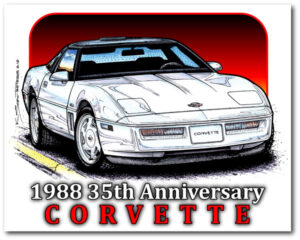 If you are looking to get into a special edition Corvette at a bargain price, the 1988 35th Special Edition is worth consideration. This was the third “special edition” Corvette – the first and second being the 1978 Silver Anniversary and the 1982 Collector Edition Corvettes. The first was a $399 two-tone paint option (15,283 units ordered) and the second $4,247 package, dripping with features; including special paint, turbine aluminum wheels, elaborate striping and badges, and best of all, a functioning rear hatch. Chevrolet sold a total of 6,759 units.
If you are looking to get into a special edition Corvette at a bargain price, the 1988 35th Special Edition is worth consideration. This was the third “special edition” Corvette – the first and second being the 1978 Silver Anniversary and the 1982 Collector Edition Corvettes. The first was a $399 two-tone paint option (15,283 units ordered) and the second $4,247 package, dripping with features; including special paint, turbine aluminum wheels, elaborate striping and badges, and best of all, a functioning rear hatch. Chevrolet sold a total of 6,759 units.
The 35th Special Edition cost $4,795 on top of the $29,489 base price of the 1988 Corvette. The package was available on coupes-only and included the following: two-tone white paint with a black B-pillar roof bow, white door handles and horizontal molding, 17-inch white wheels, transparent black roof panel, and special badges. The interior had white leather seats with embroidery, a white steering wheel, and special interior accents. Chevrolet only offered 2,050 units.
The 1988 Corvette only had two “performance” options, the Z51 Performance Handling Package for $1,295 and the Z52 Sport Handling Package for $970. There was also an assortment of small performance enhancements that included; the $40 heavy-duty radiator, the $22 Performance Axle, $75 Radiator Boost Fan, and the $110 Oil Cooler, there were no other performance options. A fully-loaded 1988 Corvette 35th Special Edition could cost just under $40,000
The reason I call the 1988 35th Special Edition a “bargain” is because if you go to VetteFinders.com, you can find this car with an asking price between $12,000 and $17,000 (2016 dollars), depending on mileage. What you’ll actually pay for one is up to your negotiating skills. The L98 engine had a lot of easy red meat left inside and the suspension can be improved without getting too far away from stock. The look is clean and overall totally unique – a great way to get into a unique Corvette!
August 31, 1956 – Harley Earl outlines the program for the XP-64 and directs that three vehicles be delivered by December 15, 1956
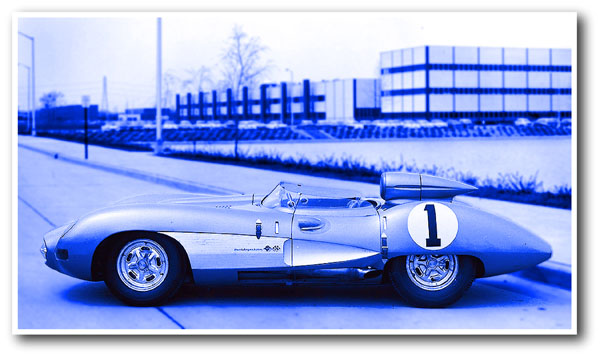 The legendary Harley Earl was a complex man. He was supremely creative, innovative, open to new ideas, and at times extremely difficult. By 1956 Earl had been a GM power player for 29 years and knew the “in’s and out’s” of working the GM corporate system – he was a master at the art of “the Big Bluff.”
The legendary Harley Earl was a complex man. He was supremely creative, innovative, open to new ideas, and at times extremely difficult. By 1956 Earl had been a GM power player for 29 years and knew the “in’s and out’s” of working the GM corporate system – he was a master at the art of “the Big Bluff.”
Earl shook up the troops by bringing in a Jaguar D-Type and proposed replacing the Jaguar’s inline-six DOHC engine with a fuel-injected small-block Chevy and creating a new Corvette-like body. Earl knew two important personality facts: First, he knew that Duntov wanted to build racecars. And second, Ed Cole, the new Chevrolet General Manager, wanted to win at Le Mans as much as Duntov!
Zora saw big problems with the Jaguar/Chevy engine swap, besides he wanted to be the one building a racecar to take to Le Mans, not the engineers at Jaguar, by proxy through him! So Duntov took the bait, with full approval from Cole. From there, it was an unrealistic construction race to get the car ready for Sebring. The project was so rushed and ill-timed that it was almost doomed from the beginning.
While Duntov and his crack team were building the structure of the XP-64, using a Mercedes 300SL as a model for the birdcage frame, Earl put Bob McLean in charge of styling the XP-64. The front fender humps with the faired-in headlights were from the original Corvette and the side-coves and toothy grille were from the then-current 1956 Corvette. While the XP-64’s styling is totally 1950s-dated, it is still a handsome car
They say, “Timing is everything.” But the timing of the XP-64, later known as the Corvette SS, could not have been worse. Not only was the construction rushed to the point where there was almost no “development” on the car, leading to an embarrassing debut at Sebring, but the car arrived just before the enactment of the 1957 AMA Ban on manufacturers’ involvement in automobile racing. Orders from the top came down, “Stop ALL racing activities!” And POOF! With the stroke of a pen, the planned Le Mans assault with at least three Corvette SS racers came to a screeching halt! – Scott


